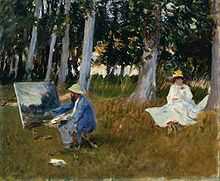En plein air

En plein air (French pronunciation: [ɑ̃ plɛn ɛʁ]) is a French expression which means "in the open air," and is particularly used to describe the act of painting outdoors, which is also called peinture sur le motif ("painting on the ground") in French. It can also be used to describe other activities where the person partakes in an outdoor environment.
Artists have long painted outdoors, but in the mid-19th century working in natural light became particularly important to the Barbizon school and Impressionism. The popularity of painting en plein air increased in the 1870s with the introduction of paints in tubes (resembling modern toothpaste tubes). Previously, each painter made their own paints by grinding and mixing dry pigment powders with linseed oil. The Newlyn School in England is considered another major proponent of the technique in the latter 19th century.[1]

It was during this period that the "Box Easel", typically known as the French Box Easel or field easel, was invented. It is uncertain who developed it first, but these highly portable easels, with telescopic legs and built-in paint box and palette, made treks into the forest and up the hillsides less onerous. Still made today, they remain a popular choice even for home use since they fold up to the size of a brief case and thus are easy to store.[2]

French Impressionist painters such as Claude Monet, Camille Pissarro, and Pierre-Auguste Renoir advocated en plein air painting, and much of their work was done outdoors, in the diffuse light provided by a large white umbrella. In the second half of the nineteenth century and beginning of the twentieth century in Russia, painters such as Vasily Polenov, Isaac Levitan, Valentin Serov, Konstantin Korovin and I. E. Grabar were known for painting en plein air. American Impressionists, too, such as those of the Old Lyme school, were avid painters en plein air. American Impressionist painters noted for this style during this era included, Guy Rose, Robert William Wood, Mary Denil Morgan, John Gamble, and Arthur Hill Gilbert. The Canadian Group of Seven and Tom Thomson are examples of en plein air advocates.

The popularity of outdoor painting has endured throughout the 20th century and into the 21st century.[3][4]
Notable associated artists


- Henri Biva
- Ralph Wallace Burton
- Mary Cassatt
- William Merritt Chase
- Robert Clunie
- John Constable
- Lovis Corinth
- William Didier-Pouget
- Rackstraw Downes
- Carl Eytel
- Antonio López García
- Arthur Hill Gilbert
- Vincent van Gogh
- Marvin Mangus
- Willard Metcalf
- Claude Monet
- Berthe Morisot
- Edgar Payne
- Robert Antoine Pinchon
- Camille Pissarro
- William Preston Phelps
- Pierre-Auguste Renoir
- Guy Rose
- John Singer Sargent
- Joaquín Sorolla
- Anthony Thieme
- Tom Thomson
- Andrew Winter
- Robert William Wood
- Mary Agnes Yerkes
See also
References
| Wikimedia Commons has media related to Plein air. |
- ↑ "Newlyn School, Landscape Painting Artist Colony, Cornwall: History, Artists, Stanhope Forbes, Frank Bramley". Visual-arts-cork.com. Retrieved 2010-08-20.
- ↑ "Plein Air". PBS. 2007-08-06. Retrieved 2010-08-20.
- ↑ "Artists who work 'en plein air' share their motivations: Arts". adn.com. 2010-06-06. Retrieved 2010-08-20.
- ↑ "Plein Air Painting - Painting Outside Plein Air". Painting.about.com. 2010-08-16. Retrieved 2010-08-20.